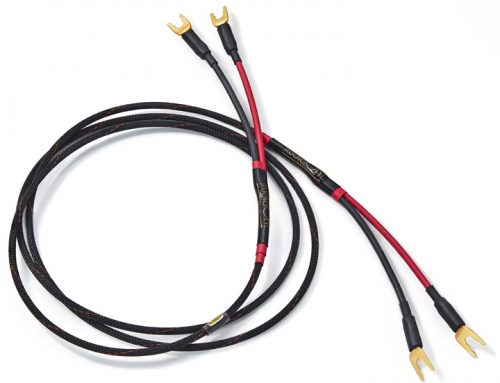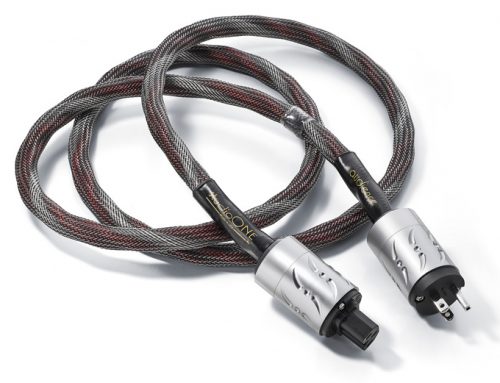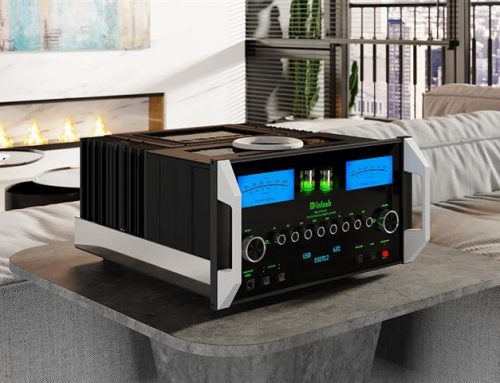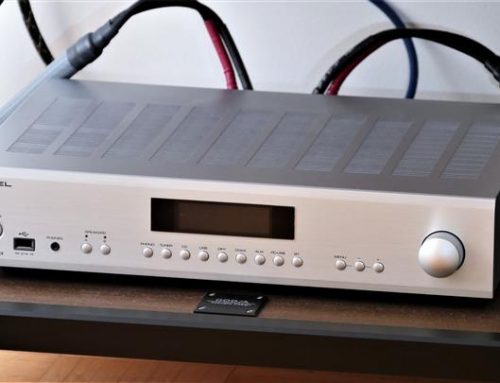As I assembled the system, I decided to see how far I could push Yamaha’s ambitious integrated. The 100 w/channel (8 ohm) spec and the extended short term output numbers of up to 290W (2 ohm) looked promising, plus the 26.7 lb weight indicated a robust power supply, so the Apogee Duetta Signature full range ribbons were chosen as the speaker challenge. They present a demanding, inefficient load that requires a combination of high current horsepower and finesse to sing with conviction, constituting a tough test for any contender. In the event the Yamaha might falter, I had two stand mounted alternative loudspeakers waiting in the wings, but happily, this situation never materialized. For speaker cables, I went with the Madison Audio Lab e3 Extreme 2, a nicely balanced choice with the advantage of interchangeable connectors and the digital duty fell to the Signal Cable digital optical and the Belkin Gold series USB, both stalwart overachievers.
The phono stage I could not evaluate, as my turntable and once extensive record collection are no longer with me. Headphone sessions rotated between the Audio Technica ATH-W1000 Sovereigns, the HiFiMan HE-400s, and the Sennheiser 598s, to explore different scenarios. Digital sources were handled by my Wyred 4 Sound Music Server on the PCM side and a trusty Dell laptop for the DSD and 32/384 music. This arrangement was due to USB compatibility limitations between the Linux based Music Server and the necessary Windows and Mac supported ASIO Yamaha/Steinberg driver.
Setting up and configuring a computer for high quality USB music playback is generally a chore, and finding a program that will take advantage of these new leading edge 32/284 PCM and DSD formats in native resolution had the potential to be difficult. Thankfully for the Windows crowd, Yamaha has gone the extra mile to make the process practically painless, even for the relative neophyte. The company website supplies extensive support by providing download access and instructional information for drivers as well as a compatible freeware Windows program player, Foobar2000, which comes with simple, step by step screenshots for download and installation. As a result, the installation of the ASIO Yamaha/Steinberg USB Driver and the program player onto the laptop proved quick and flawless. Mac users will need to seek out an alternative program to take advantage of the new 24/384 and DSD formats in native playback.
I treated the A-S801 to a requisite break in process, carefully increasing the level of difficulty of the musical source material over a few weeks to assess limitations of resolution, tonal balance, dynamics, as well as handling of image and soundstage. While the tone and loudness controls offered clean playback and unobtrusive fine tuning advantage, I found that engaging Pure Direct bypass switch resulted in a significant performance enhancement on all parameters, especially ambient information recovery, so going forward, assume this condition of use. The headphone output proved remarkably similar in character to the main outputs, constituting good news for those looking to the A-S801 as a superior quality DAC/Pre. Except for revealing the inherent differences in sonic character between the different brands of headphones, the Yamaha played no favorites in its ability to deliver the fundamental musical goods, and since it likewise benefited from the Pure Direct option, it was engaged for evaluation.
Out of the box, tonal balance was quite neutral, exhibiting appropriate smoothness at the extreme top and good extension and control at the bottom. There was initially a slight bit of extra texture on the edge of female vocal material, but this disappeared over the duration of the listening sessions. The final overall character translated warmth on recordings where it existed but did not inherently exhibit that trait, opting more for an “engineering neutral” balance. Where the A-S801 proved unusually proficient was in the departments of resolution and dynamics. Sabre based DACs have precisely that hallmark signature and Yamaha has done exemplary work marrying that DAC to their amplification in the A-S801. This unit breathed both nuance and fire within its power limits on music from Reference Recordings, Dorian, Linn and FIM. As the break-in period progressed, this breathtaking behavior evolved from being obvious and overt to becoming intrinsic to the musical event, imbuing it with a powerful, emotional ebb and flow. The Yamaha amplifier maintained its dynamic integrity over a very wide volume range, possessing a low dynamic floor with exceptional gradation. Soundstage width was Cinemascope from the first day, with good lateral focus. Projection and depth were mildly compressed in the beginning, but gained respectable proportions over the course of time, as did front to back focus. Basic noise levels were low.
Did the Apogee speakers present a problem? Ultimately, only in terms of absolute achievable volume levels, where some compression and roughness began to manifest. (The Apogees do like their horsepower.) Outside of that the A-S801 had a responsiveness that rivaled some of the best combination of products that have been in house, and flaunted levels that I would deem creditable. The Yamaha was kind to recordings, not showing disadvantage to lower resolution compressed material, yet also demonstrating the superior virtues of better recorded fare with powerful conviction. The headphone output proved no mere afterthought, but a noteworthy performer. That puts this feisty integrated in the enviable position of being technologically advanced, user friendly and sonically superior. You may question the need for its vast arsenal of digital ability, but Yamaha has wisely recognized the shifting movement from hard source music to streaming and digital download. The growing dominance of these sectors, along with the evolution to higher quality recordings validates the forward looking design philosophy embodied in the A-S801, making it near future proof. It will attract based on versatility, but it will please on performance. If you are in the market for a quality two channel integrated that can do justice to just about every musical format, the Yamaha A-S801 is an attractively priced powerhouse that may just be your ultimate statement piece.
Yamaha
www.yamaha.ca
416-298-1311
1-855-300-7811
Yamaha A-S801
Integrated Amplifier
Price: $1099 CAD





